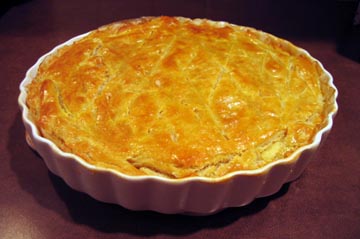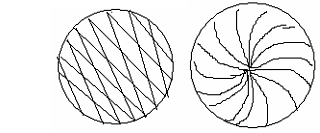Kings Day is also known as the Epiphany and takes place on January 6th. It’s the day the Three Kings are said to have presented their gifts to Jesus.
In France, Kings Day is called Le jour des rois or La fête des rois. In honor of this day they eat Galette des Rois or Kings Cake. Last year I wrote about this fun little French fête and posted a recording of the song J’aime la galette or I Love Cake!
The cake they eat most traditionally in northern France is a flat round cake with an almond/butter filling called frangipane. The tradition is to bake a trinket or bean inside the cake. It’s called la fève in French, which means broad bean. That’s because originally they always baked a real broad bean inside the cake. Now the trinket is also called la fève.
Whoever gets the slice with la fève is King or Queen for the day. They’re given a golden cardboard crown to wear all day long. Their duty as king or queen is to buy or make the next galette des rois!

Since trinkets are hard to find outside of France, Spain and New Orleans (where they have a similar tradition), a good alternative is a whole almond (without the shell of course).
Here’s a delicious recipe for Galette des Rois…
Recipe for Kings Cake – Galette des Rois
Tart Pan about 10 inches in diameter
2 layers of Puff Pastry*
7/8 cup ground-up Almonds
1 cup Powdered Sugar
7 T. + 1 1/2 t. softened Butter (just under 1 stick)
2 T. Rum (optional) or 1 1/4 t. Orange Flower Water (optional)
2 Eggs (keep one of the yolks separate)
A little Milk1 Fève – trinket, bean or nut (must I say it? be careful – could be a choking hazard!)
*I bought the Pepperidge Farm brand puff pastry which comes in square sheets. If your puff pastry comes in square sheets or doesn’t fit your tart pan, you’ll need to roll it out with a rolling pin on a lightly floured surface. I’ll explain how below.
1) If you bought frozen puff pastry, thaw it in advance according to the directions on the package.
2) Pre-heat the oven to 350°F or 180°C. Grease the tart pan with butter.
3) Mix all ingredients [except for 1 egg yolk, milk and puff pastry] with electric whisk until creamy.
4) Stretch puff pastry with the rolling pin, on a lightly floured surface, until it fits the pan going up the sides (even a little more) and spread the first layer of puff pastry in the pan. Prick with a fork.
5) Spread the cream filling evenly on the first layer of puff pastry and bury the trinket into it.
6) Roll out the 2nd layer of puff pastry with the rolling pin to make it big enough to fit over the first layer. Moisten the rim of the 1st layer of puff pastry with water and cover the first layer with the second layer of puff pastry.
7) Pass the rolling pin on the edge of the pan to cut off the excess dough, then press the two edges together with your finger to make them stick.
8) Make some little holes in the top to allow the steam out or the rim will burst and the filling will overflow.
9) Draw diamonds or half circles starting from the center to the rim like in the diagram below.
10) Brush the top with the yolk mixed with a small amount of milk. This will give it a nice golden color.
Bake in oven for around 25 minutes. Check from 20 minutes until baked a nice golden brown.
Here are the metric equivalents of the ingredients:
125g Ground Almonds
125g Powdered Sugar
100g Softened Butter
I made this recipe with Orange Flower Water which I purchased on the internet at The Spice House. It gave the Galette des Rois a very unique taste.
Many thanks to Monique Palomares of Mama Lisa’s World en français and Monique’s former colleague Geneviève for the delicious recipe! Thanks also to Monique for her explanation of the tradition and for the diagram and to Monique’s Class of 2006 for the wonderful recording of J’aime la galette.
Merci et bon appétit!
-Lisa
This article was posted on Tuesday, January 2nd, 2007 at 6:45 pm and is filed under Canada, Countries & Cultures, Desserts, Epiphany, France, French, French Kids Songs, Galettes des Rois or Kings Cake, Holiday Songs, Holidays Around the World, J'aime la galette - I Love Cake!, Kings Cake, La fête des rois or Kings Day, Languages, Mama Lisa, Recipes of the World. You can follow any responses to this entry through the RSS 2.0 feed. You can skip to the end and leave a response. Pinging is currently not allowed.
22 Responses to “Kings Day in France and a Recipe for French Kings Cake”
Leave a Reply


























November 10th, 2007 at 4:35 pm
ok i noticed that you said “j’aime” meant love and “j’aime” means like not love. “J’adore” means love. So get it right … sorry but that was just really bugging me!
December 3rd, 2007 at 12:23 pm
Sorry, Ashley, but how do you explain the expression “Je t’aime” if aime isn’t “love?” I speak fluent French, my husband is French, and we use “Je l’aime ca!” for “I love it!” all the time. Pitty you for being bugged over something so minor and incorrect to boot….
December 13th, 2007 at 3:01 pm
Yeah sry ashley but j’aime means to like or to love, j’aime ma famille i love my family so your wrong
December 18th, 2007 at 3:41 pm
I found rhis info very useful. I am doing a project in french calss about kings cake. I am also french but canadian french. I speak fluent french too!
Merci!
Katy
March 18th, 2008 at 9:18 pm
je l`aime ca…its not french ,but j`aime ca is….sorry.
veronique
May 8th, 2008 at 8:02 am
I loved the recipie but gallete is supposed to be layered and thick oh and by the way aime means like in some casses and love in some je t’adore kinda means i like you
May 10th, 2008 at 4:52 am
Well guys, I’m French and…
– You can say “Je l’aime, ça” = “This, I love/like it” (you’re insisting) or “J’aime ça” = “I love/like this” (it’s just a statement) and both are correct.
– The word “galette” comes from “galet” = shingle, pebble, the French definition being “stone polished and rounded by the action of the sea, the torrents and the rivers or the glaciers. So a galette is round and flat (the sort of flat spare tires are called galette too). Whether it’s layered or not doesn’t matter (les “galettes de Pont Aven” are shortbread!) and if it’s too thick we won’t call it a galette.
– Love/like: it highly depends on what/whom it refers to and of the situation i.e. the who, where, when, why and how of the conversation. Roughly:
1. About People: when you say “Je t’aime”(period) to someone it means “I love you” (period). But if you say “je l’aime bien” it means that you like him/her, and if you say “je l’aime beaucoup it means that you love him/her but you’d say that about your friends or people you highly appreciate. You wouldn’t say “Je t’aime beaucoup” to your husband-wife/boy-girl-friend/lover-mistress etc… because s/he would ask “Why! don’t you love me?” If you see someone in the street and you’d think “Oh, I like this one!” in French we’d say “Oh, il/elle me plaît!” (and nothing about “aime”). About “adorer” we usually use it when someone did something that made us very happy: if a friend of ours gave us as a present, something we were craving for, we’d say “Merci, je t’adore!” ; we can imagine saying “je t’adore” to our husband-wife etc… during intimate moments. But… we’d never say this as a statement such as “I love you, I want to marry you” because then it’d mean “I worship you” so unless s/he is an egomaniac, s/he’ll wonder if we’re in our right mind.
2. About Things: we say “ça me plaît” = I like it , “j’aime…” = I like it/I love it or “j’adore” = I love it, the translation would mostly depend on the tone in your voice and/or what is said about the thing both/either showing how much you like/love it.
September 6th, 2008 at 7:52 am
I, too, am a REAL French….old lady now. I think how words are said depends on where you are from in France or Canada. My family says the same words exactly as everyone else in here has mentioned and it also depends on how fast we talk. Does it really matter how a word is said as long as the meaning is there? Sounds like our young ladies who professed how correctly a word is used are either American schooled OR maybe speak as my cousins in Paris which to us down South sounds backwards. hehehe Lighten up kids…..life’s to short to quibble over a couple of letters.
January 1st, 2009 at 6:01 pm
Hello, thank you for posting this lovely recipe. I am writing from Australia and would like to check the metric details for the extra butter and the rum? Is ‘T’ a tablespoon or does it stand for something else? I assume cooks’ tablespoons are the same the world over, but if it means something else, could you please provide me with a metric equivalent.
Many thanks and enjoy the Epiphany!
January 1st, 2009 at 6:11 pm
T. stands for Tablespoon
Here’s the metric equivalent I found online:
1 tablespoon = 15 ml
On one site, it said the Australian metric equivalent of a tablespoon is 20 ml. Is that correct that it’s different?
May 18th, 2009 at 9:12 am
hey hey thats enough with the bickering, eh?! cut it out. i’m a crotchy old woman and i love french recipes and i dont need to hear all of this rubbish when i am just trying to find some decent recipe ! hmmm!
August 19th, 2009 at 9:51 pm
wow these people have a lot of problems
September 11th, 2010 at 10:27 pm
J’aime= I like. J’aime bien….I really like. J’adore=I love
Don’t worry about it. I am still learning myself. I have a long way to go. If you are worried about your French take up French classes at l’universitaire…Bonne chance…
May 24th, 2011 at 12:51 pm
is there an almond substitute i am allergic and need to make this recipe for a project , sugeestions are welcome.
January 5th, 2012 at 6:21 pm
Why do you guys insist on correcting each other when you don’t even know what’s up? I am in my third year of French class, and I wouldn’t even dream of correcting someone who obviously knows what they are talking about. And for the chick that said j’aime does not mean love. Were you using Google translate? And the one correcting Je l’aime ca. Have you been to America? Where phrases can be used differently, and said differently? Yeah…other countries are like that too. I know it is hard to believe. Stop trying to jump people’s cases if you have no idea what you are talking about. It is annoying.
Anyways! This was a fantastic article! I didn’t know that French King Cakes looked like that. I had always though they were just the circle ones with the whole Mardi Gras look going on. In our French class we are having sixth graders come over to our class and we get to teach them French. My group was assigned to Le Jour Des Rois, and we had no idea what to do! But what kid doesn’t love cake?! Thanks a ton. (:
January 5th, 2012 at 6:23 pm
Also, Marie-Sandra. I love you, haha. (: I didn’t know the term ‘Down-South’ was used in France as well. That is amazing. (:
January 6th, 2012 at 8:52 pm
[…] but tradition says I have to share. Here is a fantastic recipe that I have used a couple of times. Mama Lisa’s Galette Recipe It was given to her by a real live French woman, so you can trust it. Plus, I also like the […]
February 20th, 2012 at 5:27 pm
Im taking French in school at the moment and j’aime means I like..does j’adore means I love. I just wanted to say that.
October 1st, 2012 at 5:37 pm
I hate to point out the obvious… but, anyone who passed first grade English knows that starting a sentence with a lower case letter and also not capitalizing I, is a big “no no”.
Those who live in glass houses shouldn’t cast stones…
October 1st, 2012 at 5:50 pm
I apologize for my comment. It wasn’t nice and I really don’t care who or who doesn’t use proper grammar. I was directed to this site for a French assignment and was sidetracked by all of this nonsense.
Meanwhile, it’s a beautiful day here in Clear Lake, Texas and I am going outside to enjoy this lovely weather…
Au revoir!
January 6th, 2016 at 11:22 pm
[…] Panettone is the bread you see sold in boxes in stores in December. It’s originally from the city of Milan in Italy. Nowadays, it’s eaten in many countries during the Christmas holiday season… including for New Year’s and the Epiphany (in some places it even replaces King’s Cake). […]
January 2nd, 2021 at 6:51 pm
French Canadian tradition: La fête des rois. The feast of the kings. Jan 6th. (Also Ukrainian Christmas celebrated here in this area of Alberta, Canada.)
As children, we always celebrated Christmas Eve with “le réveillon”. After midnight mass, people would have a family celebration with meat pie “tourtière” & potato pie, and other treats. Children might even be allowed a small sip of homemade wine. You might be up until 2 or 3 a.m.
Presents were opened January 1st. New Years Day.
On January 6, we celebrated “la fête des rois”. It was very exciting. A plain white cake – un gâteau blanc – a flat white cake was baked. We wrapped in wax paper a dime & a nickel and sometimes a penny. These were baked in the cake.
Whoever got the dime was king, the nickel was queen, and if there was a penny, it was no big deal. Whoever was king could tell others what to do for the day. You had to do what you were asked to do. It was all in fun, but it was very exciting for children. You picked fun things to do.
Some people would put a bean and a pea instead.
That was in the 1950’s and into the 1960’s.